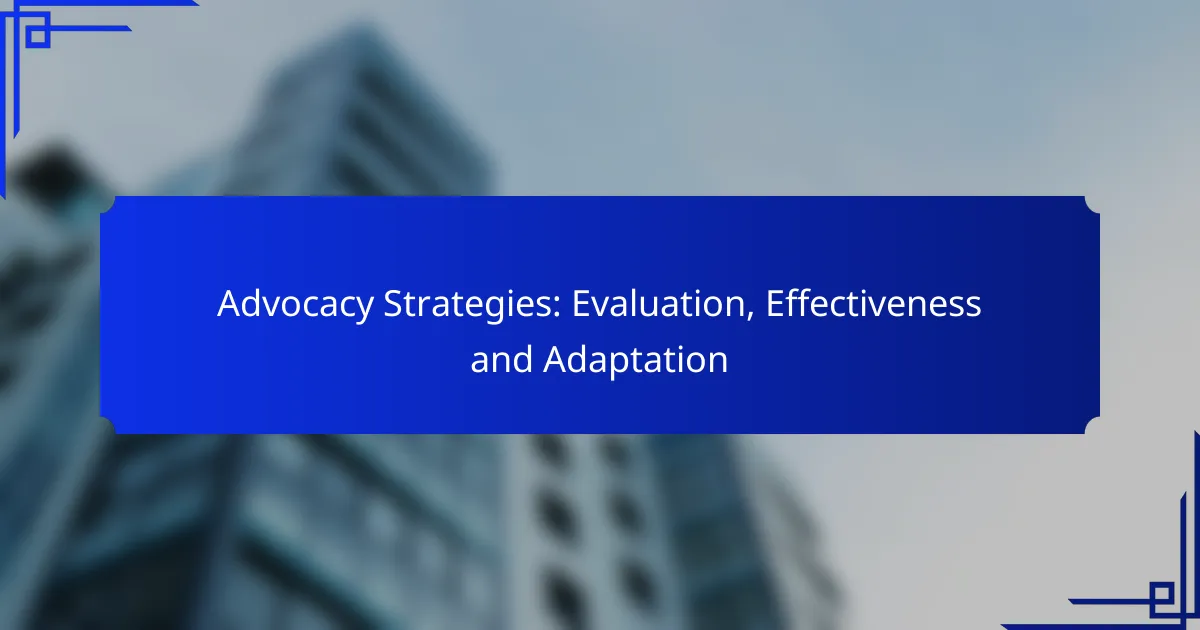Advocacy strategies are essential tools for nonprofits aiming to influence public opinion and drive meaningful change. By employing methods such as grassroots mobilization and digital campaigning, organizations can effectively engage communities and build coalitions. Evaluating these strategies is crucial, as it allows for the assessment of outcomes against established goals, enabling organizations to adapt and enhance their approaches for greater impact.
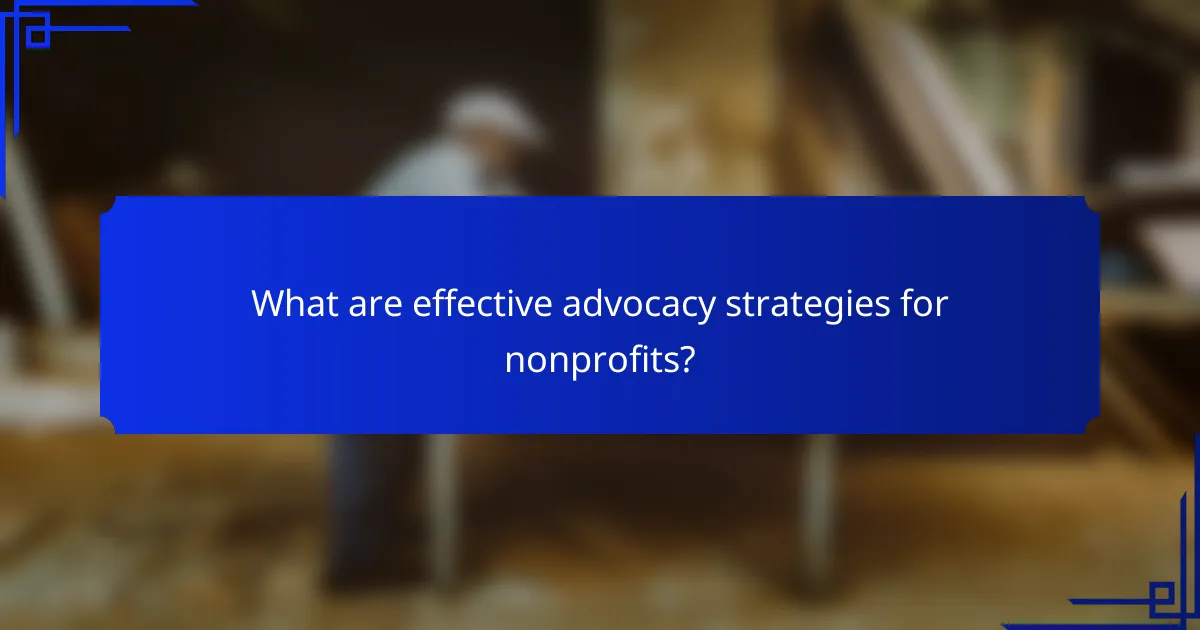
What are effective advocacy strategies for nonprofits?
Effective advocacy strategies for nonprofits include grassroots mobilization, coalition building, digital campaigning, policy advocacy, and community engagement. Each strategy plays a crucial role in influencing public opinion and driving change within communities.
Grassroots mobilization
Grassroots mobilization involves rallying community members to advocate for a cause. This strategy focuses on building a base of support through local events, petitions, and direct outreach. Engaging individuals at the community level can amplify voices and create a powerful collective impact.
Nonprofits should consider organizing town hall meetings or community forums to discuss issues and gather support. Utilizing social media to share stories and mobilize action can also enhance grassroots efforts.
Coalition building
Coalition building is the process of forming alliances with other organizations or groups that share similar goals. This strategy enhances resources, expertise, and influence, allowing nonprofits to tackle larger issues more effectively. Collaborating with diverse stakeholders can lead to innovative solutions and broader reach.
To build a successful coalition, nonprofits should identify potential partners, establish clear objectives, and maintain open communication. Regular meetings and shared resources can strengthen the coalition’s effectiveness.
Digital campaigning
Digital campaigning leverages online platforms to raise awareness and mobilize support for advocacy efforts. This strategy can include social media campaigns, email outreach, and online petitions. Digital tools allow nonprofits to reach a wider audience quickly and efficiently.
Nonprofits should create engaging content that resonates with their target audience, using visuals and storytelling to enhance their message. Monitoring analytics can help refine campaigns for better engagement and impact.
Policy advocacy
Policy advocacy focuses on influencing legislation and public policy to achieve desired outcomes. This strategy involves researching relevant policies, engaging with lawmakers, and mobilizing constituents to support specific initiatives. Effective policy advocacy can lead to systemic change that benefits communities.
Nonprofits should develop clear policy positions and build relationships with policymakers. Providing data and personal stories can strengthen their case and encourage action from decision-makers.
Community engagement
Community engagement emphasizes building relationships with local residents and stakeholders to foster trust and collaboration. This strategy involves listening to community needs and incorporating their feedback into advocacy efforts. Engaged communities are more likely to support initiatives that reflect their interests.
Nonprofits can facilitate community engagement through surveys, focus groups, and participatory events. Ensuring that diverse voices are heard can enhance the legitimacy and effectiveness of advocacy initiatives.
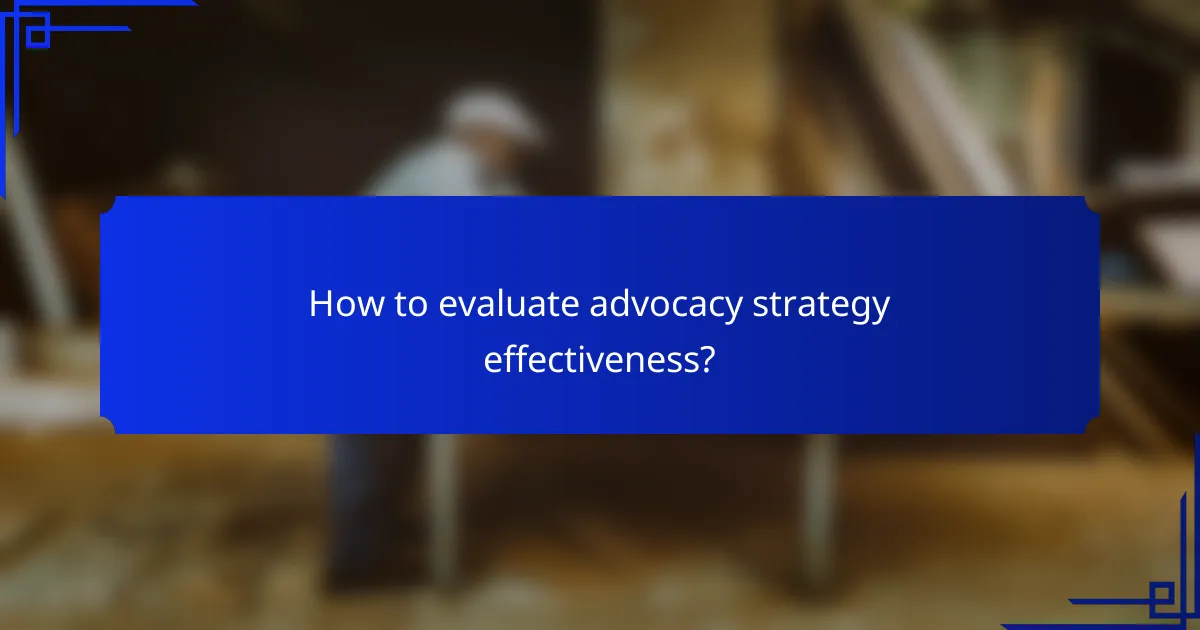
How to evaluate advocacy strategy effectiveness?
Evaluating the effectiveness of an advocacy strategy involves assessing the outcomes achieved against the goals set. This process requires systematic measurement, feedback collection, and data analysis to understand what works and what needs adjustment.
Outcome measurement
Outcome measurement focuses on quantifying the results of advocacy efforts. This can include tracking changes in policy, public awareness, or community engagement. Use specific indicators such as the number of new policies enacted or shifts in public opinion, aiming for clear, measurable targets.
For instance, if advocating for environmental regulations, measure the number of new laws passed or the percentage increase in community participation in sustainability programs. Setting benchmarks helps gauge progress over time.
Feedback mechanisms
Feedback mechanisms are essential for gathering insights from stakeholders involved in or affected by advocacy efforts. This can include surveys, interviews, or focus groups to capture qualitative data on perceptions and experiences. Regularly soliciting feedback ensures that strategies remain relevant and responsive.
For example, after a campaign, conduct a survey among participants to assess their views on the effectiveness of the messaging and activities. This information can guide future efforts and improve engagement strategies.
Data analysis
Data analysis involves examining the collected information to identify trends and patterns in advocacy outcomes. Utilize both qualitative and quantitative methods to draw comprehensive insights. Tools like statistical software can help visualize data and highlight significant findings.
When analyzing data, consider comparing pre- and post-advocacy metrics to evaluate impact. For instance, if advocating for health policy changes, analyze hospital admission rates before and after the campaign to assess effectiveness. This analysis informs necessary adjustments to enhance future advocacy strategies.
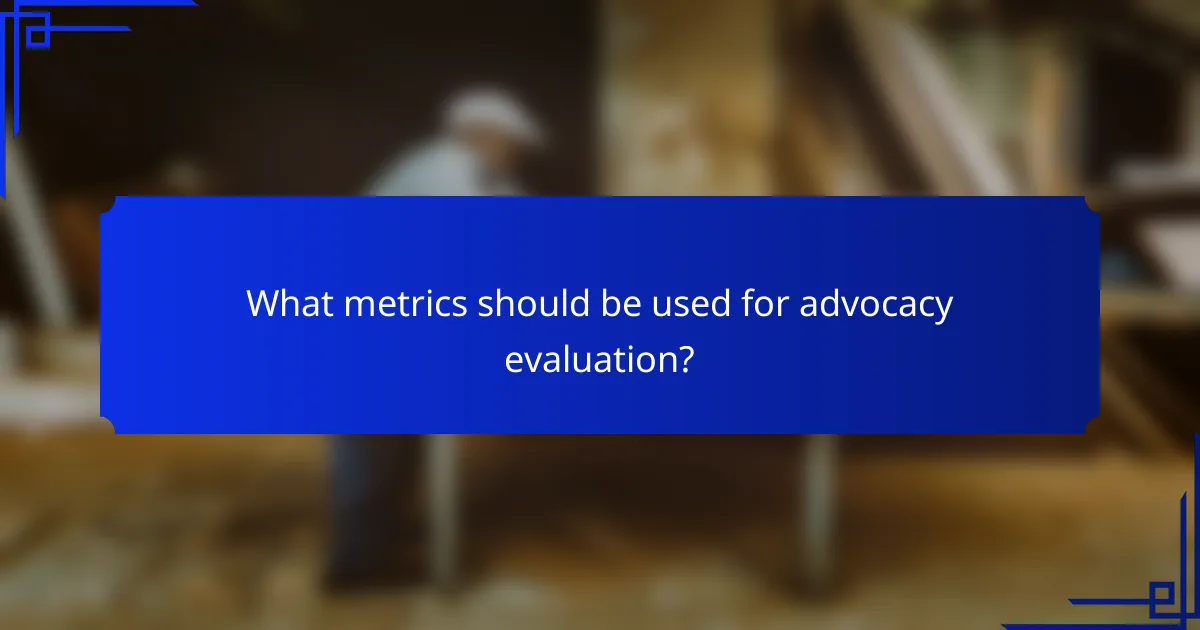
What metrics should be used for advocacy evaluation?
Advocacy evaluation should focus on metrics that measure engagement, impact, and reach. These metrics help organizations assess their effectiveness and adapt strategies to improve outcomes.
Engagement metrics
Engagement metrics track how actively stakeholders interact with advocacy efforts. This includes social media interactions, event participation, and feedback from surveys. High engagement often indicates a strong connection with the audience.
Common engagement metrics include likes, shares, comments, and attendance numbers. For example, a campaign might aim for a 20% increase in social media shares over a specific period.
Impact metrics
Impact metrics evaluate the tangible effects of advocacy initiatives on policy or community change. These can include changes in legislation, shifts in public opinion, or measurable improvements in community conditions. Understanding these impacts is crucial for demonstrating the value of advocacy work.
To assess impact, organizations might track the number of policies influenced or the percentage of the target audience that reports increased awareness. For instance, a successful campaign might lead to a 30% increase in public support for a specific issue.
Reach metrics
Reach metrics measure the extent of advocacy efforts across different demographics and geographies. This includes the number of people exposed to messaging through various channels, such as media coverage, social media impressions, and email campaigns. A broad reach can amplify advocacy messages significantly.
Organizations should aim to quantify their reach by tracking metrics like unique website visitors or media mentions. For example, a campaign might target reaching 100,000 individuals through a combination of online and offline efforts.
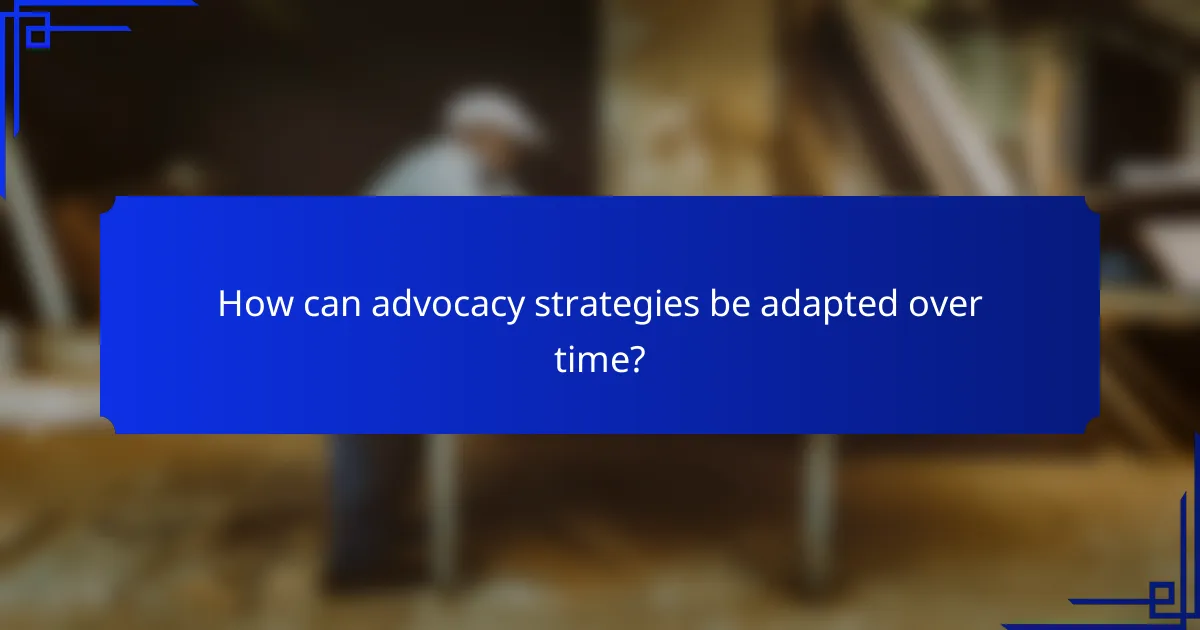
How can advocacy strategies be adapted over time?
Advocacy strategies can be adapted over time by continuously assessing their effectiveness and making necessary adjustments based on feedback, trends, and stakeholder input. This iterative process ensures that advocacy efforts remain relevant and impactful in changing environments.
Continuous feedback integration
Integrating continuous feedback is crucial for adapting advocacy strategies. Regularly collecting input from target audiences and stakeholders helps identify what is working and what needs improvement. Utilize surveys, focus groups, and social media monitoring to gather insights.
For effective feedback integration, establish a routine for reviewing and analyzing the data collected. This could be monthly or quarterly, depending on the pace of change in your advocacy area. Be prepared to pivot quickly based on the feedback received to maintain momentum.
Market trend analysis
Market trend analysis involves monitoring changes in public opinion, policy developments, and social movements that could impact advocacy efforts. Keeping an eye on these trends allows organizations to anticipate shifts and adapt their strategies accordingly.
Use tools like Google Trends, industry reports, and news outlets to stay informed about relevant changes. Regularly assess how these trends align with your advocacy goals and adjust messaging or tactics to better resonate with current sentiments.
Stakeholder input
Engaging stakeholders for input is essential in refining advocacy strategies. Stakeholders, including community members, policymakers, and partner organizations, can provide valuable perspectives and insights that enhance advocacy efforts.
Establish regular communication channels, such as advisory boards or stakeholder meetings, to facilitate ongoing dialogue. Actively seek their opinions on proposed strategies and be open to incorporating their suggestions to foster collaboration and support.

What role does technology play in advocacy?
Technology significantly enhances advocacy efforts by enabling organizations to reach wider audiences, gather insights, and streamline communication. Tools such as social media, data analytics, and customer relationship management (CRM) systems are essential for effective advocacy strategies.
Social media platforms
Social media platforms are critical for advocacy as they allow organizations to engage with supporters in real-time and amplify their messages. By utilizing platforms like Facebook, Twitter, and Instagram, advocates can share updates, mobilize supporters, and create viral campaigns.
To maximize impact, tailor content specifically for each platform. For instance, use eye-catching visuals on Instagram, concise messages on Twitter, and detailed posts on Facebook. Regularly analyze engagement metrics to refine your approach and increase effectiveness.
Data analytics tools
Data analytics tools help advocacy organizations assess the effectiveness of their campaigns and understand their audience better. By analyzing data from social media interactions, website traffic, and survey responses, advocates can identify trends and measure the impact of their efforts.
Consider using tools like Google Analytics or social media insights to track key performance indicators (KPIs). Set specific goals, such as increasing engagement rates or expanding your reach, and adjust your strategies based on the insights gathered.
CRM systems
CRM systems are vital for managing relationships with supporters and stakeholders in advocacy. These systems help organizations track interactions, segment audiences, and personalize communication, which can lead to stronger engagement and support.
When selecting a CRM, look for features that allow for easy integration with other tools, such as email marketing platforms. Regularly update your database to ensure accuracy and maintain engagement by sending targeted messages based on supporter interests and past interactions.

What are common challenges in advocacy efforts?
Common challenges in advocacy efforts include limited resources, lack of public awareness, and difficulty in measuring impact. These obstacles can hinder the effectiveness of campaigns and make it harder to adapt strategies to changing circumstances.
Resource Constraints
Resource constraints are a significant challenge for many advocacy groups. Limited funding can restrict outreach, staffing, and the ability to conduct research or develop materials. Organizations often need to prioritize their initiatives, which can lead to tough decisions about where to allocate resources.
To mitigate resource constraints, advocacy groups can seek partnerships with other organizations, apply for grants, or engage in crowdfunding. Utilizing volunteers effectively can also help maximize limited resources.
Public Awareness and Engagement
Raising public awareness and engaging the community is crucial for successful advocacy. Many issues lack visibility, making it difficult to mobilize support. Effective communication strategies are essential to inform the public and encourage participation.
Utilizing social media platforms, hosting community events, and collaborating with influencers can enhance visibility. Tailoring messages to resonate with specific audiences can also improve engagement and support.
Measuring Impact
Measuring the impact of advocacy efforts presents another challenge. Without clear metrics, it can be difficult to assess effectiveness and adapt strategies accordingly. Establishing benchmarks and collecting data throughout the advocacy process is essential for evaluation.
Consider using surveys, feedback forms, and social media analytics to gather insights. Regularly reviewing progress against goals allows organizations to adjust tactics and improve outcomes over time.
